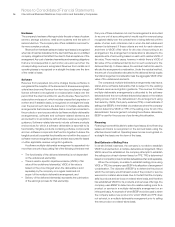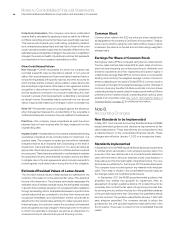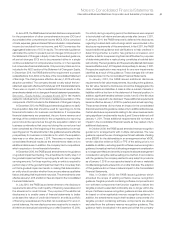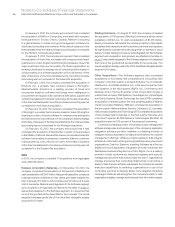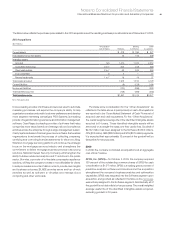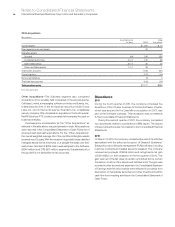IBM 2011 Annual Report Download - page 88
Download and view the complete annual report
Please find page 88 of the 2011 IBM annual report below. You can navigate through the pages in the report by either clicking on the pages listed below, or by using the keyword search tool below to find specific information within the annual report.
Notes to Consolidated Financial Statements
International Business Machines Corporation and Subsidiary Companies86
Collectively Evaluated—The company records an unallocated
reserve that is calculated by applying a reserve rate to its different
portfolios, excluding accounts that have been specifically reserved.
This reserve rate is based upon credit rating, probability of default,
term, characteristics (lease/loan), and loss history. Factors that could
result in actual receivable losses that are materially different from the
estimated reserve include sharp changes in the economy, or a significant
change in the economic health of a particular customer that represents
a concentration in the company’s receivables portfolio.
Other Credit Related Policies
Non-Accrual—Certain receivables for which the company has
recorded a specific reserve may also be placed on non-accrual
status. Non-accrual assets are those receivables (impaired loans or
nonperforming leases) with specific reserves and other accounts for
which it is likely that the company will be unable to collect all amounts
due according to original terms of the lease or loan agreement. Income
recognition is discontinued on these receivables. Cash collections
are first applied as a reduction to principal outstanding. Any cash
received in excess of principal payments outstanding is recognized
as interest income. Receivables may be removed from non-accrual
status, if appropriate, based upon changes in client circumstances.
Write Off—Receivable losses are charged against the allowance
when management believes the uncollectibility of the receivable is
confirmed. Subsequent recoveries, if any, are credited to the allowance.
Past Due—The company views receivables as past due when
payment has not been received after 90 days, measured from the
original billing date.
Impaired Loans—As stated above, the company evaluates all financing
receivables considered at-risk, including loans, for impairment on a
quarterly basis. The company considers any loan with an individually
evaluated reserve as an impaired loan. Depending on the level of
impairment, loans will also be placed on non-accrual status as
appropriate. Client loans are primarily for software and services and
are unsecured. These loans are subjected to credit analysis to evaluate
the associated risk and, when deemed necessary, actions are taken
to mitigate risks in the loan agreements which include covenants to
protect against credit deterioration during the life of the obligation.
Estimated Residual Values of Lease Assets
The recorded residual values of lease assets are estimated at the
inception of the lease to be the expected fair value of the assets at
the end of the lease term. The company periodically reassesses the
realizable value of its lease residual values. Any anticipated increases
in specific future residual values are not recognized before realization
through remarketing efforts. Anticipated decreases in specific future
residual values that are considered to be other-than-temporary are
recognized immediately upon identification and are recorded as an
adjustment to the residual value estimate. For sales-type and direct-
financing leases, this reduction lowers the recorded net investment
and is recognized as a loss charged to financing income in the period
in which the estimate is changed, as well as an adjustment to
unearned income to reduce future-period financing income.
Common Stock
Common stock refers to the $.20 par value per share capital stock
as designated in the company’s Certificate of Incorporation. Treasury
stock is accounted for using the cost method. When treasury stock
is reissued, the value is computed and recorded using a weighted-
average basis.
Earnings Per Share of Common Stock
Earnings per share (EPS) is computed using the two-class method.
The two-class method determines EPS for each class of common
stock and participating securities according to dividends and
dividend equivalents and their respective participation rights in
undistributed earnings. Basic EPS of common stock is computed by
dividing net income by the weighted-average number of common
shares outstanding for the period. Diluted EPS of common stock is
computed on the basis of the weighted-average number of shares of
common stock plus the effect of dilutive potential common shares
outstanding during the period using the treasury stock method. Dilutive
potential common shares include outstanding stock options, stock
awards and convertible notes. See note P, “Earnings Per Share of
Common Stock,” on page 117 for additional information.
Note B.
Accounting Changes
New Standards to be Implemented
In May 2011, the Financial Accounting Standards Board (FASB)
issued amended guidance and disclosure requirements for fair
value measurements. These amendments are not expected to have
a material impact on the consolidated financial results. These
changes were effective January 1, 2012 on a prospective basis.
Standards Implemented
In September 2011, the FASB issued additional disclosure requirements
for entities which participate in multi-employer pension plans. The
purpose of the new disclosures is to provide financial statement
users with information about an employer’s level of participation in
these plans and the financial health of significant plans. The new
disclosures are effective for the full year 2011 financial statements.
The company does not participate in any material multi-employer
plans. There was no impact in the consolidated financial results as
the changes relate only to additional disclosures.
In September 2011, the FASB issued amended guidance that
simplified how entities test goodwill for impairment. After an
assessment of certain qualitative factors, if it is determined to be
more likely than not that the fair value of a reporting unit is less than
its carrying amount, entities must perform the quantitative analysis
of the goodwill impairment test. Otherwise, the quantitative test(s)
become optional. The guidance was effective January 1, 2012 with
early adoption permitted. The company elected to adopt this
guidance for the 2011 goodwill impairment test performed in the
fourth quarter. There was no impact in the consolidated financial
results.




